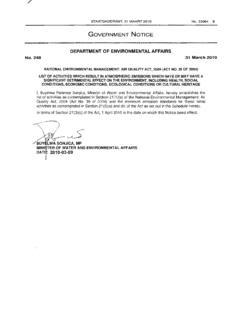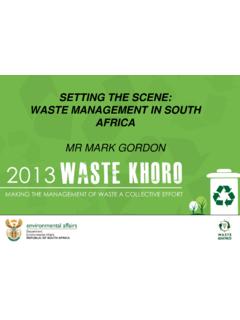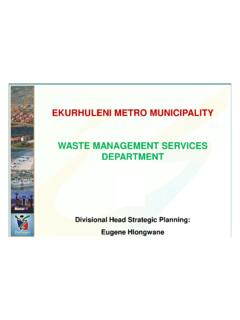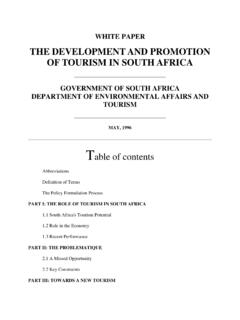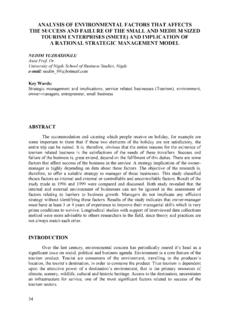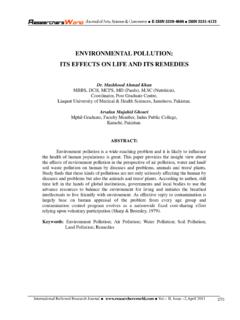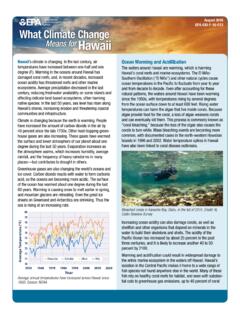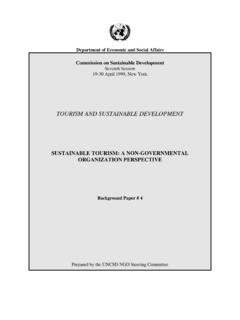Transcription of Management Information Series 10 - environment.gov.za
1 Integrated environmental Management Information Series Strategic environmental Assessment 10 D epart ment of E nvironm ent al A f f airs and tourism S t ra t e g i c En v i ro n m e n t a l Asse ssm e n t Other topics in the Series of overview Information documents on the concepts of, and approaches to, integrated environmental Management are listed below. Further titles in this Series are being prepared and will be made available periodically. Sequence of release and titles are subject to change. Information Series 0: Overview of Integrated environmental Management Information Series 1: Screening Information Series 2: Scoping Information Series 3: Stakeholder Engagement Information Series 4: Specialist Studies Information Series 5: Impact Significance Information Series 6: Ecological Risk Assessment Information Series 7: Cumulative Effects Assessment Information Series 8: Cost Benefit Analysis Information Series 9: Life Cycle Assessment Information Series 10: Strategic environmental Assessment Information Series 11: Criteria for determining Alternatives in EIA.
2 Information Series 12: environmental Management Plans Information Series 13: Review in environmental Impact Assessment Information Series 14: environmental Auditing Information Series 15: environmental Impact Reporting Information Series 16: environmental Economics ISSUED BY. Department of environmental Affairs and tourism Private Bag X447. Pretoria 0001 South Africa This document is available on the DEAT web site: PLEASE NOTE: This document is intended as an Information source and cannot take the place of legal advice in a specific situation governed by legislation. The document is not a guideline document, but serves as a reference and supportive text. This document will not take the place of official guidelines and regulations published by DEAT. COPYRIGHT Department of environmental Affairs and tourism 2004.
3 ALL RIGHTS RESERVED. This document is copyright under the Berne Convention. Apart from the purpose of private study, research or teaching, in terms of the Copyright Act (Act No. 98 of 1978) no part of this document may be reproduced or transmitted in any form or by any means, electronic or mechanical, including photocopying, recording or by any Information storage and retrieval system, without permission in writing from DEAT. Likewise, it may not be lent, resold, hired out or otherwise disposed of by way of trade in any form of binding or cover other than that in which it is published. ENQUIRIES AND COMMENTS. All enquiries and comments should be addressed to: The Director: environmental Impact Management Department of environmental Affairs and tourism Private Bag X447.
4 Pretoria 0001 South Africa REFERENCING. When referencing this document, it should be cited as follows: DEAT (2004) Strategic environmental Assessment, Integrated environmental Management , Information Series 10 , Department of environmental Affairs and tourism (DEAT), Pretoria. ISBN 0-9584728-6-6. PREFACE. This document is one of a Series of overview Information documents on the concepts of, and approaches to, Integrated environmental Management (IEM). IEM is a key instrument of South Africa's National environmental Management Act (NEMA). South Africa's NEMA promotes the integrated environmental Management of activities that may have a significant effect (positive and negative) on the environment. IEM provides the overarching framework for the integration of environmental assessment and Management principles into environmental decision-making.
5 It includes the use of several environmental assessment and Management tools that are appropriate for the various levels of decision-making. The aim of this document Series is to provide general Information on techniques, tools and processes for environmental assessment and Management . The material in this document draws upon experience and knowledge from South African page 1. practitioners and authorities, and published literature on international best practice. This document is aimed at a broad readership, which includes government authorities (who are responsible for reviewing and commenting on environmental reports and interacting in environmental processes), environmental professionals (who undertake or are involved in environmental assessments as part of their professional practice), academics (who are interested in and active in the environmental assessment field from a research, teaching and training perspective), non-government organisations (NGOs) and interested persons.
6 It is hoped that this document will also be of interest to practitioners, government authorities and academics from around the world. This document has been designed for use in South Africa and it cannot reflect all the specific requirements, practice and procedures of environmental assessment in other countries. This Series of documents is not meant to encompass every possible concept, consideration, issue or process in the range of environmental assessment and Management tools. Proper use of this Series of documents is as a generic reference, with the understanding that it will be revised and supplemented by detailed guideline documents. ACKNOWLEDGEMENTS. Note All sources used have been acknowledged by means of complete references. Principal Author Michelle Audouin and Kogi Govender (CSIR).
7 Project Co-ordinators Anben Pillay (DEAT) and Nigel Rossouw (CSIR). Editorial Review Pat Morant, Nigel Rossouw (CSIR) and Anben Pillay (DEAT). Peer Review John Raimondo Departmental Review Mark Gordon (DEAT). SUMMARY. The primary purpose of environmental Impact Assessment the concept of sustainable development. SEA also has the (EIA) is to determine and evaluate the environmental potential to promote an integrated system of planning implications of development, to inform decision-making that incorporates sustainability objectives into the planning at the project level. However, there are a number of more process. strategic decisions that are typically made at the planning, programming and policy level that influence the nature of There is no single approach to SEA that can be applied in development.
8 Strategic environmental Assessment (SEA) all circumstances. Various SEA processes have been has therefore evolved, complementary to EIA, in order to developed internationally, which have their own specific determine the environmental implications of policies, plans strengths in a particular context. For the purpose of the and programmes. discussion in this document, selected examples of SEA. approaches are briefly provided, categorised according to EIA focuses on the positive and negative impacts of a key characteristics or adaptations of each approach. These specific development project once it has been formulated. examples are presented according to the following key The role of SEA, however, is to allow for the decision- adaptations: maker to proactively determine the most suitable * The integration of sustainability objectives into plans development type for a particular area, before development and programmes.
9 Proposals are formulated. * The environmental assessment of a region ( Regional environmental Assessment);. The role of SEA is determined by its place in the decision- * The environmental assessment of sector plans and making process. SEA can be used to assess a proposed programs ( Sectoral environmental Assessment);. policy, plan or programme that has already been developed; * The nature of the policy, plan or programme and level or it can be used to develop, evaluate and modify a policy, of decision-making;. plan or programme during its formulation. This distinction * The need for simplicity and speed in a context of is dependant on the stage in the decision-making process limited resources; and at which the SEA is undertaken and the stakeholders * Flexibility that enables self-assessment and the early involved.
10 Integration of environmental considerations into the development of policies, plans and programmes. In addition, SEA can have both an advocacy role, where its primary purpose is to raise the profile of the environment, The practice of SEA is relatively new and is still evolving. or an integrative role, where the focus is on combining The application and testing of different approaches is environmental , social and economic considerations. recommended as a way of contributing to learning. The sharing of Information is important for the development Through the integration of environmental , social and and consolidation of SEA. economic objectives into the policy and planning process, SEA has the potential to assist in the implementation of page 2. S t ra t e g i c En v i ro n m e n t a l Asse ssm e n t CONTENTS.

